HM, GPK, COPD, THEM, LTI and other BFDs
This past Sunday I completed my first Half Marathon (HM). It was, as Joe Biden would say, "a Big Effing Deal" (BFD) -- not just for me, but for my wife Empar, who had to suffer the collateral agony of preparation. I'll get back to all that in a few paragraphs.
Meanwhile, on March 20, Girija Prasad Koirala (85) lost his protracted battle with COPD -- a huge BFD for Nepal. (I'll get back to COPD later, too.) GPK's passing elicited hosannas of mainstream tributes for Nepal's Messiah of Democracy and torrents of blogovitriol for the unlamented egomaniac dynast.
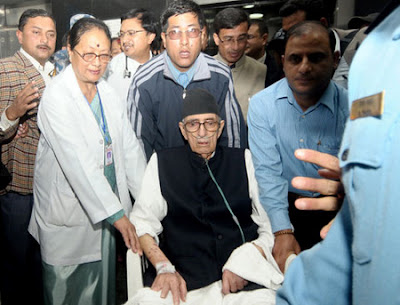
Girija Prasad Koirala as he was released from the hospital in Singapore on March 17. Photo by Narendra Shrestha
GPK who? you ask. Good question.
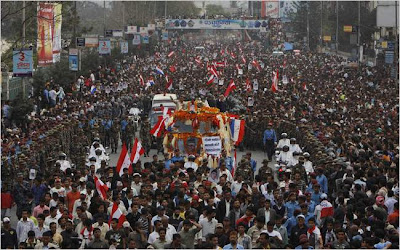
Koirala funeral procession (photo from The Economist, March 27 2010)
Girija's father, Krishna Prasad Koirala, was a leading businesman in Biratnagar, in southeast Nepal near the Indian border. The story is that KP's property was confiscated by a jealous Prime Minister, Chandra Shumshere Rana. Forty-five members of the Koirala family then went into exile in India until Chandra Shushere Rana died a few years later.

Maharaja Jang Bahadur Rana (1816-1877), anglophile prime minister who marginalized the royal family and initiated his own Rana dynasty
The Ranas, to simplify a bit, had usurped the power of the squabbling Shah family in the mid-nineteenth century, keeping the kings under virtual house arrest while they pursued vainglorious anglophile fantasies (neo-classical Victorian palaces, insanely brocaded and epauletted uniforms, pancake makeup and so on) -- as well as certain progressive reforms such as the abolition of suttee (widow immolation); many felt that the Ranas carried their anglophilia a bit too far in dragging the country into two world wars on the side of the oppressive British Empire.
While in exile, all five of KP Koirala's sons became activists committed to the overthrow of the despotic Rana regime. The worm turned in 1950, when King Tribhuvan fled to India. He returned a few months later, with armed support of the Nepali Congress (NC) party. The NC was modeled on and assisted by the Indian National Congress, the party leading the Indian independence movement against the British Empire. One of the exiled activists who founded the NC in 1947 was GP Koirala's elder brother Bishweshwar Prasad Koirala. GP himself played a role in organizing the labor movement and got arrested as a result of the first big strike. In fact three of the brothers not only spent time in prison but also eventually served as prime minister of Nepal. Matrika Prasad Koirala, the eldest, served two terms in the 1950s. BP Koirala was the first democratically elected prime minister, serving for 18 months (1959-60) before being deposed by King Mahendra, in a coup reversing Tribhuvan's power-sharing reforms.
Girija Prasad, the greatest of the Koiralas, was General Secretary of the Nepali Congress from 1975 to 1991; he was a key player in the 1990 Jana Andolan (People's Movement), leading to the end of the pseudo-parliamentary one-party Panchayat system and the drastic limitation of King Birendra's power. In 1991, GPK became Nepal's first democratically elected prime minister since the ouster of MPK.
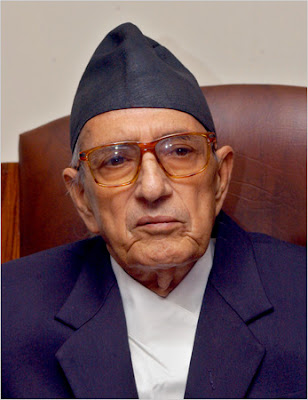
Girija Prasad Koirala
Over the next two decades, GPK served four terms as prime minister. He was in office when the Maoist insurgency began in 1996, and is credited with incompetent policies that turned a potentially minor dust-up into an ugly ten-year war that led finally to the toppling of Nepal's monarchy. On the other hand, GPK is also credited with having brokered the end of the war, resulting in the belated inclusion of the Maoists in the democratic government. And GPK was on hand to congratulate Prachanda, the erstwhile terrorist warlord, when he was sworn in as first President of Nepal in 2008.
Right now, Nepal faces a May deadline for the drafting of a new constitution. It is widely agreed that the removal of Girija Prasad Koirala is a severe setback to that effort. There are still quite a few Koiralas afoot, many of whom have been the subjects of charges of corruption and nepotism. One Koirala worth keeping an eye on is GPK's daughter Sujata; she became Deputy Prime Minister in October 2009. Another Koirala worth watching, for other reasons, is GPK's grand-niece, Manisha, a Bollywood megastar.

Manisha Koirala, Bollywood star
Okay, so much for GPK. But what the heck is COPD? Another good question! In fact, that's just what I asked when I was diagnosed with it a couple of years ago.
COPD, or chronic obstructive pulmonary disease, refers to chronic bronchitis and emphysema, two diseases that frequently occur together, both of which entail narrowing of the airways and shortness of breath. COPD is generally caused by air pollution: in 80-90% of American cases, the primary cause is smoking cigarettes. Unlike asthma, COPD is not reversible. If you don't die of something else first, it will kill you. It's one of the more unpleasant ways to die, rather like protracted drowning. And it is (officially) the fourth leading cause of death in the United States. "Officially," because it appears that a huge proportion of cases are misdiagnosed or simply undiagnosed; the actual incidence is probably much higher than indicated by the official statistics. Worldwide, the standing of COPD is lower, probably around six in the list of leading causes of death, but surging forward rapidly as smoking and industrial pollution become more prevalent in countries like China and India.
No way!, you protest, if COPD is such a BFD, why haven't I heard of it? Again: good point. For one thing, it's a relatively new designation. As I said, I had never heard of it when I was diagnosed. Even my primary care physician knew very little about it.
As with many non-infectious diseases (like arthritis, cardiomyopathy, acute fatigue syndrome, polymyalgia, Gulf War Syndrome, post traumatic stress disorder, and post traumatic stress), we simply haven't done our homework. The etiology is not understood, and there may be widespread belief that the whole thing is just invented. Because the early symptoms are not spectacular -- no diarrhea, purple lesions, coughed up blood -- no one pays a lot of attention; end-game scenarios are often dismissed as "natural causes" or "old age."
Fortunately, there are now some anti-inflammatory medications (including GlaxoSmithKline's Advair, which I take) that can temporarily slow the progress of COPD, improving one's chances of succumbing to an asteroid, aneurysm, or other less excruciating agent. In the last year or so, TV advertising for Advair has become so prevalent that American couch potatoes are finally becoming aware of COPD. On the other hand, Advair is expensive: a one-month supply costs $280. Even with insurance, my co-pay is $40/month, so I scrimp (and avoid my insurance cap) by taking only half the prescribed dose. I don't know if that's a huge mistake, because there are no board-certified pulmonologists in Ithaca NY, where I live. Personally, I doubt that anyone really knows. It's a relatively new medicine.
One of the things that is known about COPD is that exercise helps. In response to breathlessness, most people naturally cut back on physical activity. The result is "deconditioning," weakening of those core muscles that are going to have to work harder as the disease progresses. A COPD diagnosis should be a wake-up call, a reminder to get off your butt, lose weight, and start working on that Bucket List. Hence last Sunday's Half Marathon (HM).
Actually, that's just half the HM story. I'll get back to the other half in a couple of paragraphs.
As far as COPD epidemics are concerned, Nepal is the perfect storm. Now, those of you who read my article a couple of months ago on earthquakes (Haiti's grim reminder to Nepal) may be thinking, "Here he goes again with another disaster alarm!" -- and in fact, some of the same factors are at work, primarily because natural disasters tend to quickly transmogrify into a medical catastrophes.

Trekker crossing the last bridge before Namche Bazar (photo by S. Sicroff)
First of all, Nepal's highly accidented topography, subtropical location, and monsoon climate contribute to an extreme diversity and abundance of all sorts of flora. The seasonal efflorescence of natural allergens (pollens and spores), as well as the year-round blight of mildews and moulds -- visible on building walls as unsightly dark streaks -- produce not just the garden variety of allergies but a high incidence of asthma and other respiratory maladies. (I picked up my own "adult-onset asthma" in Kathmandu during the summer of 1981.)
Second, Kathmandu's bowl-shaped setting results in frequent thermal inversions. In the troposphere, or lower atmosphere, the highest temperatures are normally at ground level, where the sun's radiation is transformed to heat by liquids and solids and then dissipated back into the air. As the air warms up, it becomes lighter, rising in columns and allowing cooler air to move in and take its place. This convection, or mixing process, tends to sweep away much of the dust and pollutants as well as natural allergens. In Kathmandu, and many other towns and cities of Nepal, the cooler air perched on the slopes above the urban centers will slide downhill at night, displacing the warm air. The large mass of cooler air does not warm up very quickly, and the warmer air above has no reason to subside, which means that the convection system switches off. A layer of smog accumulates and blocks out the solar radiation that might warm the lower air. As a result, the system can sit for weeks and months, until monsoon storms drive it out.

LTI near Jiri (photo by S. Sicroff)
Apart from the natural factors, there are strictly human contributers. Nepal, like most developing countries, has weak regulatory systems. Gasoline is adulterated with with kerosene and other additives that make it burn dirtier. Industrial smoke is spewed into populated areas. Garbage, including huge quantities of plastic bags and wrappings, is burned in open fires. All in all, Kathmandu is one of the most polluted cities in the world.
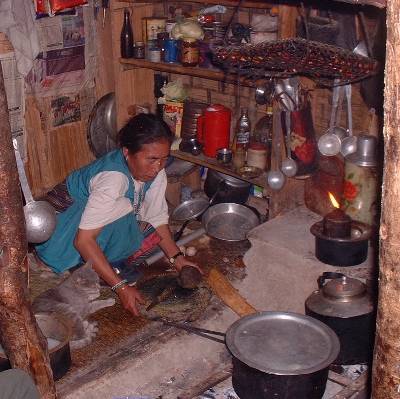
Cooking over an open stove in a Rolwaling teahouse (photo by S. Sicroff)
Pollution occurs at the individual level as well. Although some educated people know enough not to smoke, cigarette consumption starts at a very young age. Children are an important part of the workforce, hawking, touting, begging, serving as conductors on buses and smaller public conveyances -- and smoking is part of the work culture. Smoking is common among women, as well. And the cigarettes most consumed by the poorer are truly vile -- harsh enough to choke a confirmed Gauloise smoker.
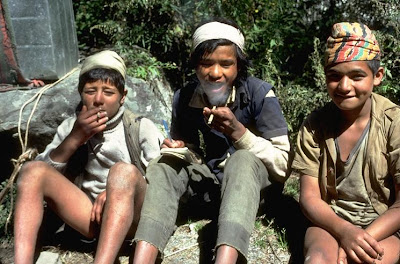
Porters resting on the Long Trek In (photo by S. Sicroff)
As I noted above, 80-90% of COPD cases in the Unites States are attributed to smoking, but in many environments smoking is not a necessary factor. I was never a "confirmed smoker," indulging only occasionally with certain friends and generally while I played chess. Usually I just bummed cigarettes, and occasionally bought a pack to return the favor. I believe that my COPD is the result of a number of cases of acute bronchitis that I picked up in the mountains of Nepal and China, in situations where I could get no medical treatment. The wracking coughs that kept me awake for weeks on end were evidently sufficient to do permanent damage to my alveoli --those microscopic sacs at the ends of your bronchial passages where the actual transfer of oxygen and carbon dioxide takes place... provided there is sufficient elasticity to pump the air in and out.
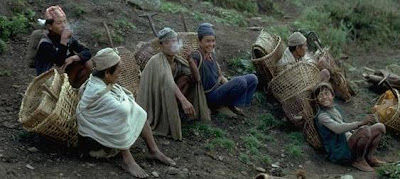
Porters in Nepal (photo by S. Sicroff)
Other personal habits contribute to respiratory disease in Nepal. People at all levels of society spit in public. You may be walking behind a well-dressed woman, beguiled by her swishing sari, and as you stroll past her she may casually unload a gob of phlegm on your pant-leg. Every morning, people all around town clear their throats and spew out the window, never worrying about who might be walking below. No one carries a handkerchief: people sneeze onto the floor, pinching off the streamers with thumb and index finger arched elegantly above their nose, before wiping them on their shirt-tail or scarf. Domestic animals (goats and chickens) will ingest the stuff either directly or in association with other unsavories; an important vector for tuberculosis is the milk of cows who pick eat vegetable waste around markets, where crowds of shoppers and vendors are spitting.
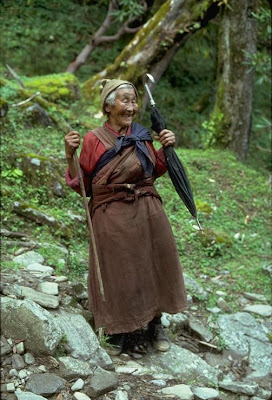
Old lady with umbrella on the trail near Junbesi (photo by S. Sicroff)
Finally, there is the danger of uncontrolled use of antibiotics. All medicines are available without prescription, and most are pretty cheap; doctors as well as self-medicators tend to resort reflexively to antibiotics whatever the illness, and patients who actually need those medicines will often take short regimes. The result is like Gold's Gym for germs: all manner of common bacteria, protozoa, and worms have developed resistance to the entire arsenal of modern medicine.
Back to my Half Marathon, and the other half of the explanation for that.
My "professional" interest (in quotation marks because I don't actually make any money from it) is backpacker trekking tourism in the Himalayas and other remote mountainous destinations. It turns out that there is a strong connection between this backpacker tourism and COPD as well as other respiratory ailments.
COPD is estimated to affect 10% of adults living in the mountains of Nepal, primarily because of smoking and indoor air pollution from traditional heating and cooking systems. Women are particularly at risk, since they do most of the cooking, and the youngest children (who remain close by their mothers) are also highly vulnerable to respiratory ailments.
Mountain tourism poses both increased risk and increased opportunities for alleviation of respiratory health problem. The increased risk factors are 1) more hours of stove and lantern use in households converted to teahouses; 2) more income available for cigarettes; 3) greater pressure to smoke exerted by Western tourists for whom smoking is a social bonding ritual.

Tea stop on the Long Trek In (photo by S. Sicroff)
On the other hand, tourism may bring prosperity and enhanced infrastructure, including electricity, better constructed housing, health care facilities, literacy, awareness of the dangers of smoking, and better sanitation. All of these can attenuate the risk of respiratory disease.
So the question is: how can we do more to make tourism a force for respiratory health instead of a contributing factor?
This is my plan: I am going to participate in the 2011 Tenzing-Hillary-Everest Marathon (THEM). (For information about this ultimate Bucket Lister, see http://www.everestmarathon.com.) As a 60-year-old COPDer who manages to stay active thanks to Advair, I will try to persuade GlaxoSmithKline to sponsor this run and to underwrite my long-term project, which is a fund-raising/consciousness-raising sports event for respiratory health in the Himalayas.
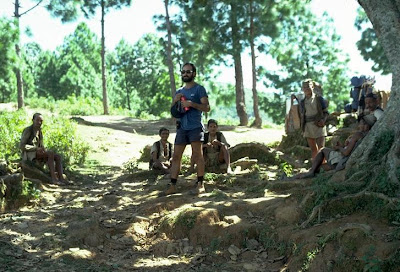
Seth at first rest-stop after the 1000-foot climb out of Lamosangu (photo by V. Hildebrand)
That event would be the Long-Trek-In Classic (LTI), a collaborative backpacking hypermarathon retracing the traditional trek from the trailhead at Jiri to Everest Base Camp, more than 100 miles away. (Alternatively, the route might begin 50 miles west at Lamosangu, which was the trailhead before the Swiss Road was completed as far as Jiri in 1985.)
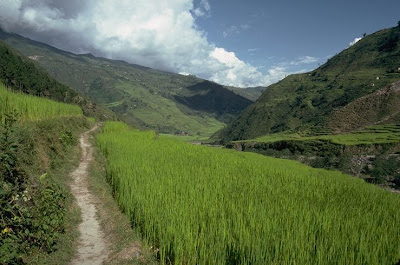
Parts of the Long Trek In weave through rice paddy (photo by S. Sicroff)
One goal would be to get people with mild or moderate COPD to participate in this event as a major Bucket Lister, and perhaps follow it with the Tenzing-Hillary Everest Marathon, from Everest back to Namche Bazar. The Long-Trek-In would give participants an opportunity to set and meet a highly demanding physical challenge. Experts agree that maintaining an active lifestyle is a key factor in slowing the progress of the disease. Preparing for and carrying out a rigorous trek is an experience that can have an impact long after the adventure is over: participants are likely to find a renewed confidence and determination to maintain an active lifestyle.
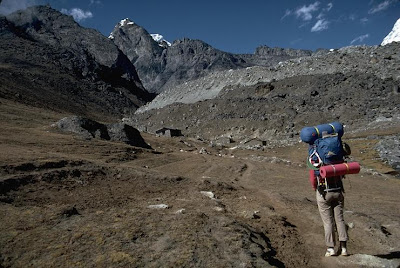
Trekker in the Pheriche valley, a dozen miles from Everest (photo by S. Sicroff)
For those who have had difficulty in giving up cigarettes, the expedition would provide a good occasion to leave them behind, and to deal with withdrawal in a supportive group situation.
Participants would also be able to discuss respiratory health with mountain villagers, and perhaps to enable them to mitigate their own risk of respiratory illness by committing to further partourism projects such as facilitation of alternative energy infrastructure.
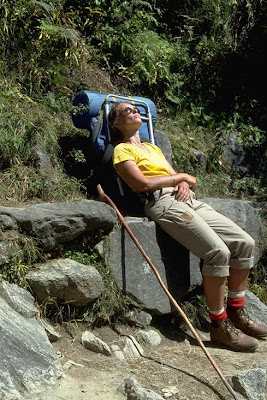
LTI trekker basking in the midday sun (photo by S. Sicroff)
So, I've completed a first step toward getting in shape, the Skunk Cabbage Classic HM in Ithaca, NY. Now comes the real marathon: not just my own long-trek-in to Everest and the Tenzing-Hillary Everest Marathon, but the long grind of recruiting sponsors and collaborators and establishing a new sporting event that may attract attention, money, and research to improve respiratory health in the Himalayas.

Runner in the Tenzing-Hillary Everest Marathon (photo courtesy of THEM)
If any of you feel like getting involved, please email me: sicroff at gmail.com.
Seth Sicroff, Nepal Editor for Wandering Educators
Manager, Sunrise Pashmina
-

- Log in to post comments


















